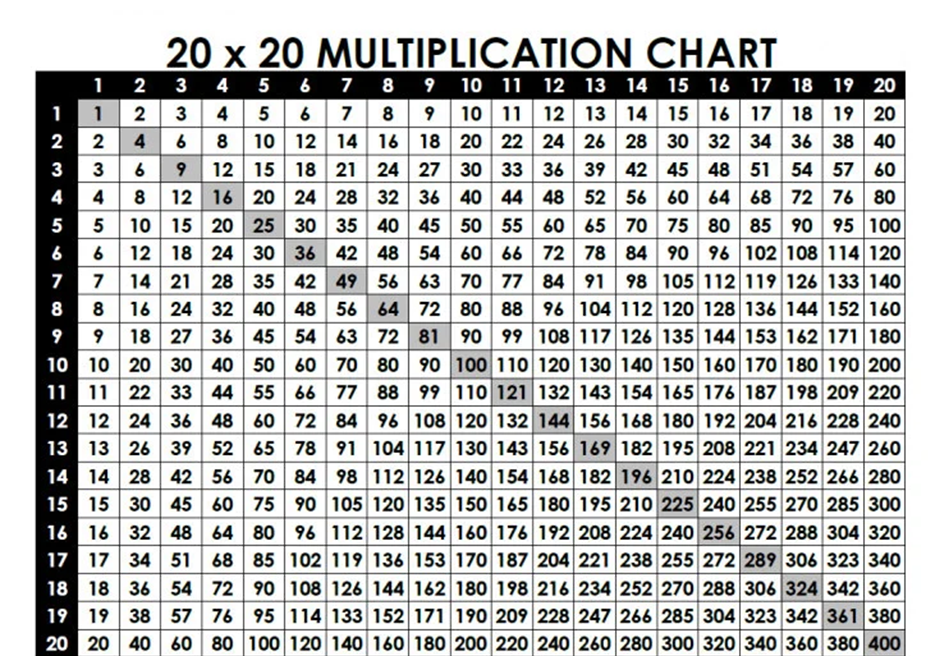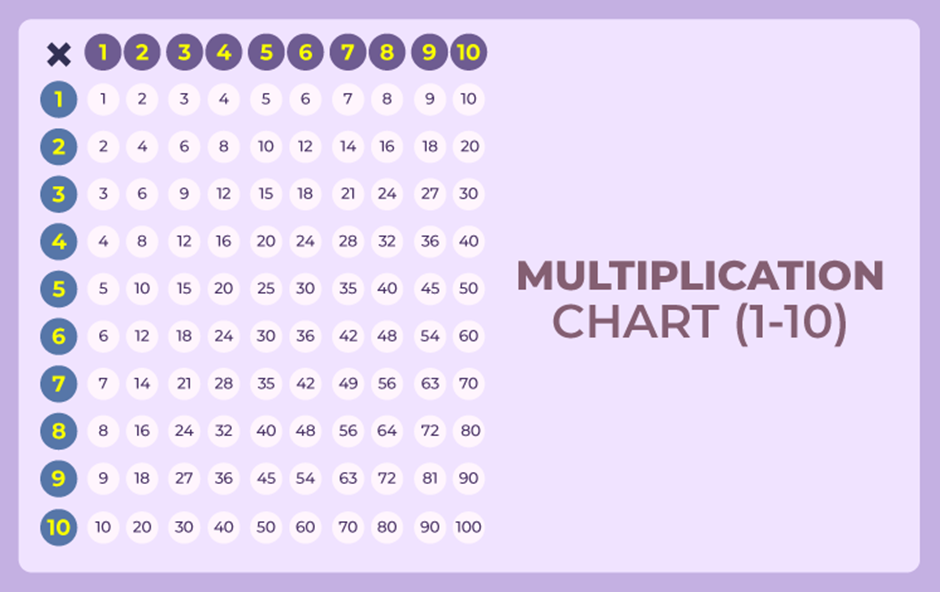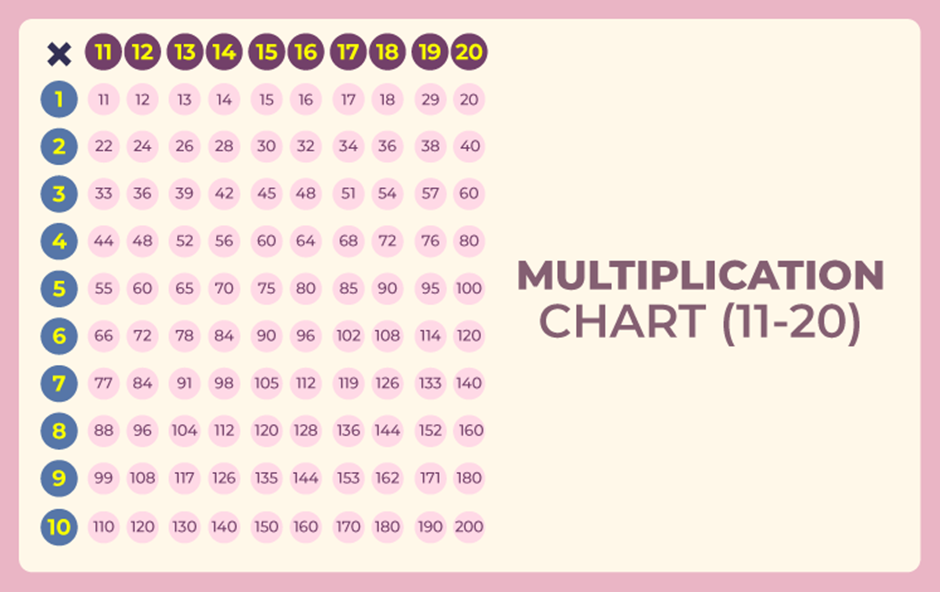Is learning multiplication tables something that your child consistently tries to avoid? I have a quick solution for you. Make use of a multiplication chart. The symbol "×," which stands for "multiplication chart," combines numbers to create a product. Scale, proportionality, and efficiency are what make it relevant. Calculations are sped up by multiplication, particularly when adding repeatedly.
Improve Math with FREE Worksheets!
It is used in geometry to calculate area and volume, as well as to lay the groundwork for deeper mathematical ideas such as algebra and calculus. Additionally, there are many real-world uses for multiplication, including scaling images and altering recipe proportions. Gaining an understanding of multiplication promotes mathematical connections, factors, and multiples, resulting in a more thorough understanding of mathematics. Since multiplication is the foundation for both basic and complex mathematical applications, mastering it is crucial for academic success.
A multiplication chart is an important tool for learning multiplication along with time tables or multiplication tables. Multiplication Chart 1-20 is the most common form of multiplication chart we get along with Multiplication Chart from 1-12 and 1-10.
Defining a Multiplication Chart
A multiplication chart is a graphical representation of the multiplication table that displays the results of multiplying integers or numbers within a specific range. It is often organized in a grid layout with rows and columns, with each cell reflecting the product of the corresponding row and column numbers.
A multiplication chart is a table that shows the product of two numbers. Typically, one set of numerals is placed in the left column, while another is written in the upper row. A multiplication chart may help you save a lot of time and energy while performing computations.
The most typical multiplication chart includes the multiplication table from 1 to 10 or 1 to 12. More detailed charts, on the other hand, might include goods with numbers up to 20 or more, depending on the required range.
How Multiplication Charts Help Children?
A multiplication chart's purpose is to reduce the need for mental math by offering a quick and simple reference for calculating the product of any two numbers within the designated range. In order to help students in learning and remembering multiplication facts, multiplication charts are often used in educational settings, especially elementary schools. Teachers and parents who wish to assist their children in learning multiplication can also benefit greatly from these resources. In a variety of contexts, multiplication charts can also be used to rapidly recall fundamental mathematical operations.
Hacks to remember multiplication chart 1-20
Many students find it challenging to memorize tables and charts numbered 1 through 20. We've included some ideas to help you memorize a multiplication chart of 1-20.
- The numbers in the multiplication chart range from 1 to 20 and their multiplied values are mostly whole numbers.
- Table 1 displays the number itself, e.g., 1×5 = 5
- Table 10 displays the values with a zero on the right side, e.g., 10×5 = 50
- Tables 2, 4, 8, and 16 have only even integers.
- To test your multiplication table/chart memorization, do random multiplication questions. Practice daily and have a set target.
Examples of Multiplication Charts
A multiplication chart is a chart that displays the multiplication tables from 1 to 20. It is highly beneficial for learning the tables quickly and easily. Above is what a multiplication chart of 1-20 looks like. It is extremely useful in learning timetables and saves a lot of time. Understanding and using multiplication tables and charts from 1 to 20 is crucial for students. They reduce mathematical concerns, make computations easier, and solve problems.
Sometimes multiplication charts are separated for students to make them easier to grasp. It may be separated into 1-10 or 1-12 for convenience. We occasionally encounter multiplication charts ranging from 11 to 20. Let's have a peek.
Multiplication is a fundamental mathematical operation that has several applications, ranging from basic everyday computations to complex mathematical concepts. It is used every day. Its significance goes beyond simple computation, contributing to the development of fundamental mathematical abilities and promoting a deeper grasp of quantitative connections.
Multiplication charts are truly magnificent and help students in many ways to remember multiplication formulas. The number game is quite fun with multiplication charts and multiplication tables. Enroll in 98thPercentile Math lessons to learn multiplication fast and efficiently in new and innovative methods. Identify and close skill gaps, as well as investigate ideas and concepts in a novel way.
Improve Math with FREE Worksheets!
FAQs
Q.1: What is multiplication?
Ans- Multiplication is the process of merging equal groupings of numbers. Multiplication is a fundamental Math ability that allows us to swiftly determine how many objects we have when they are grouped in equal groupings.
Q.2: What is a Multiplication Chart?
Ans- A multiplication chart is a table displaying the products of two integers. Typically, one set of numbers is put in the left column, while another is printed in the top row. The goods are organized into a rectangular array of numbers. Multiplication is defined as repeated addition.
Q.3: What is a multiplication table?
Ans- Multiplication table is also known as time table. A multiplication table depicts the outcomes of two multiplied numbers. It comes in really handy when it comes to learning multiplication, especially when it comes to kids.
Q.4: What are the most popular types of multiplication charts?
Ans- A multiplication chart of 1-12 is the most popular. Then comes the 1-20, 1-10 and 11-20 multiplication charts which are very helpful.
Q.5: Why do we need to learn multiplication?
Ans-We utilize multiplication in a variety of real-world scenarios, such as when we're buying in quantity or calculating how many pieces of pizza each person may have at a gathering.
Book FREE Math Trial Classes Now!

 Students/Staff
Students/Staff Parents
Parents ElevatEd
ElevatEd





-Nov-18-2025-03-57-47-3267-AM.png?width=360&length=360&name=401x226%20(6)-Nov-18-2025-03-57-47-3267-AM.png)



-Jul-22-2025-03-16-52-8797-AM.png?width=360&length=360&name=401x226%20(6)-Jul-22-2025-03-16-52-8797-AM.png)






